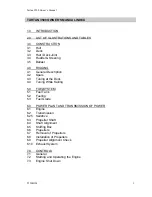
8 / 10
PRESSURE
The correct pressure for the buoyancy tube and the keel is 240 mb/3,48 PSI
(middle of the
green area of the pressure indicator).
If your boat is not equipped with an
ACCESS
pressure indicator, we recommend that you
purchase one from your Dealer. This will permit a quick and efficient control of the pressure
during inflation. Without a pressure indicator, stop inflating when buoyancy tube is sufficiently
hard so that the cones on the rear section of the buoyancy tube cannot be bent manually.
The ambient temperature of the air or
water proportionately influences the
level of internal pressure in the
buoyancy mechanism
Ambient Temperature
Internal buoyancy
mechanism pressure
+1°C
+4 mb / 0.06 PSI
-1 °C
-4 mb / 0.06 PSI
Thus, it is important to anticipate:
Because of temperature variations (especially when this variation is important between the
beginning and the end of the day, in hot areas) check and adjust the pressure in the inflated
compartments by inflating or deflating. Be sure that pressure remains within the
recommended zone, between 220 mb and 270 mb (green area).
RISK OF UNDERPRESSURE:
EXAMPLE:
Your boat is exposed on a beach in the sun (temperature=50 °C) at the
recommended pressure (240 mb/3.48 PSI). When you launch it (temperature=20 °C), the
temperature and internal pressure of the inflatable compartments will drop simultaneously (up
to 120 mb) and
YOU WILL THEN NEED TO REFLATE
until you regain the millibars lost due to
the difference between the ambient air and water temperatures. A drop in pressure at the end
of the day, when the outside temperature is dropping, is normal.
NOTE:
Proper inflation is critical to the performance of the boat. It is the pressure
in the tubes that gives your boat the necessary rigidity to perform well.
Under-inflation causes improper flexing of the tubes which will cause
early aging.
RISK OF OVERPRESSURE
EXAMPLE:
Your boat is inflated to its recommended pressure (240 mb/3.48 PSI) at the
beginning or end of the day (low outside temperature = 10 °C). Later in the day, your boat is
exposed in the sun on the beach or on a yacht deck (temperature = 50 °C). The temperature
inside the inflatable compartments may rise to 70 °C (particularly for dark buoyancy units),
doubling the initial pressure (480 mb).
YOU WILL THEN NEED TO DEFLATE
the boat to return to
the recommended pressure.
ATTENTION
IF YOUR BOAT IS OVERINFLATED, THERE WILL BE UNDUE PRESSURE
ON THE INFLATABLE STRUCTURE THAT MAY RUPTURE IT.
IN CASE OF OVERPRESSURE
STANDARD VALVE (A):
Free some air by pushing on
the diaphragm (1) with a blunt
object (like a pencil).
Beware
not to fold down the
diaphragm.
SEMI-RECESSED VALVE (B):
Release some air by pressing
the valve knob.
A
1
B




























